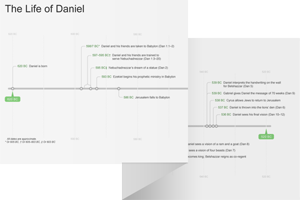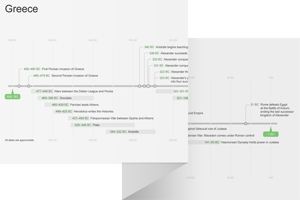8:1–14 While 2:4–7:28 was originally written in Aramaic, The first 14 verses describe the conflict between the ram and the goat. Daniel also returns to the imagery of the “little horn.” In contrast to ch. 7, there is general agreement regarding the identities of the beasts and horns in ch. 8. |
Linguistic Structure of Daniel | ||
Hebrew: 1:1–2:3 | Aramaic: 2:4–7:28 | Hebrew: 8:1–12:13 |
8:1 the third year of the kingdom of Belshazzar the king Daniel places his second vision in the reign of Belshazzar, around 548 bc (see 5:1; 7:1).
the one that appeared to me See ch. 7.
8:2 Susa The royal residence of the Persian Empire (see Esth 1:2).
Ulai An irrigation canal that ran past Susa (also rendered “Shushan”).
8:3 ram Perhaps an astrological symbol. A first-century bc zodiac list identifies Persia as a ram.
two horns The kings of Media and Persia (see Dan 8:20). Media and Persia existed as separate kingdoms until Media conquered Persia under Cyrus the Great.
(see Dan 8:20). Media and Persia existed as separate kingdoms until Media conquered Persia under Cyrus the Great.
horns were long Signifies the greatness of each kingdom.
but the one was longer than the second Persia, under Cyrus, absorbed the Median Empire and seized control of its army. See 7:5 and note.
8:4 westward and northward and southward Reflects the victorious military campaigns of Medo-Persia.
none of the beasts stood before it An apt description of the Medo-Persian military machine. For a time, their strength was unrivaled.
it became strong Like most world powers in the ancient Near East, Medo-Persia gained prestige through numerous military excursions.
8:5 a he-goat May also be an astrological symbol (see note on v. 3). The zodiac sign Capricorn is a horned goat. In some astrological traditions, Capricorn is associated with Syria. This region was included in Alexander’s empire and later passed to his general Seleucus (see v. 8 and note). The male goat represents Greece (v. 21).
from the west Alexander came from the Mediterranean—west of Mesopotamia—where the vision takes place.
and it was not touching the ground A reference to the speed of Greece’s military conquests under the direction of Alexander (see Isa 41:3 for a similar description of Cyrus).
a conspicuous horn between its eyes A reference to Alexander the Great (see Dan 8:21) and his dominance of the other Greek rulers.
(see Dan 8:21) and his dominance of the other Greek rulers.
8:7 it broke its two horns Alexander savagely attacked and defeated the Medo-Persian Empire during the reign of Darius III.
there was no one who could rescue Under the leadership of Alexander, Greece’s might was insurmountable.
8:8 at the height of its power the great horn was broken Alexander died unexpectedly at the height of his power in 323 bc.
four conspicuous At his death, Alexander divided his empire among four of his generals.
the four winds of heaven See 7:2 and note.
8:9 came forth a horn, a little one Seleucus received part of Alexander’s empire; Antiochus IV Epiphanes came from his line. The same imagery of the “little horn” from ch. 7 is used again of Antiochus IV (see 7:8 and note).
came from his line. The same imagery of the “little horn” from ch. 7 is used again of Antiochus IV (see 7:8 and note).
beautiful land Jerusalem (see Ezek 20:6, 15).
8:10 the host and some of the stars Perhaps a reference to the Jews that followed Antiochus’ Hellenization policy (see Dan 8:12 and note; compare 2 Maccabees 9:10).
trampled them Antiochus oppressed and persecuted them (see 2 Maccabees 6:9–11).
8:11 the prince of the hosts A reference either to God or the angelic prince who is Yahweh in the ot—that is, the Angel of Yahweh (compare the nearly identical phrase in Josh 5:14). The divine name Yahweh does not appear in the Hebrew for this verse (see note on Dan 9:2). The prince’s connection to the offerings and the sanctuary may identify this figure as God Himself, though the Angel of Yahweh receives an offering in Judg 6. In either case, the figure is inseparable from Yahweh. The burnt offering was associated with the temple in which the Name (i.e., Yahweh) was thought to dwell. The Name was in the Angel of Yahweh (Exod 23:20–23).
(compare the nearly identical phrase in Josh 5:14). The divine name Yahweh does not appear in the Hebrew for this verse (see note on Dan 9:2). The prince’s connection to the offerings and the sanctuary may identify this figure as God Himself, though the Angel of Yahweh receives an offering in Judg 6. In either case, the figure is inseparable from Yahweh. The burnt offering was associated with the temple in which the Name (i.e., Yahweh) was thought to dwell. The Name was in the Angel of Yahweh (Exod 23:20–23).
 Old Testament Godhead Language
Old Testament Godhead Language
 The Name Theology of the Old Testament
The Name Theology of the Old Testament
from him Antiochus outlawed Jewish religious practices, and dedicated worship to Zeus instead of Yahweh (see 1 Maccabees 1:44–50; 2 Maccabees 6:2). For a description of the regular offerings, see Exod 29:38–42; Num 28:2–8.
the place of his sanctuary The Jerusalem temple.
8:12 on account of transgression Perhaps a reference to the Jews who adopted Antiochus’ immoral Hellenistic lifestyle (see Dan 8:10; compare 1 Maccabees 1:43; 2 Maccabees 6:12).
truth The Torah, or the Law. Daniel emphasized the singular worship of the God of Israel as prescribed in the Law.
8:13 a certain holy one An angel.
transgression that makes desolate Antiochus IV erected an altar to Zeus over the existing altar in the temple (see 1 Maccabees 1:54; 2 Maccabees 6:2).
to Zeus over the existing altar in the temple (see 1 Maccabees 1:54; 2 Maccabees 6:2).
8:14 For two thousand three hundred evenings and mornings The angel measures the length of time that the sanctuary would remain defiled by the number of missed sacrifices.
8:15–27 In the last portion of this chapter, the angel Gabriel arrives to help Daniel understand the vision. Gabriel identifies the ram and the goat and describes the exploits of Antiochus in summary fashion. Antiochus’ exploits will be further detailed in Dan 11–12. |
8:15 the appearance of a man In this instance, an angel. See 7:13 and note.
8:16 the voice of a human Daniel hears a human voice—something intelligible to him.
Gabriel An angel who delivers important messages in the Bible (see 9:21; Luke 1:19, 26).
 Angels in the Bible Table
Angels in the Bible Table
8:17 I became terrified and I fell prostrate on my face See Daniel 7:15; compare 10:9; Josh 5:14; Ezek 1:28; 3:23.
son of man Describes someone in human form (see Dan 8:15; 7:13 and note).
the time of the end Refers to times when suffering will be replaced by restoration to instill hope in oppressed Jews.
8:18 he touched me Gabriel’s touch will ease Daniel’s fear and give him strength (see 10:10, 12, 18–19; Matt 17:7; Rev 1:17).
8:19 the period of wrath See Dan 8:17 and note.
8:22 four kingdoms that will arise from his nation See v. 8 and note.
8:23 transgressions are completed This language is reminiscent of 2 Maccabees 6:14–15.
skilled in riddles This ability implies wisdom in the ancient Near East (see Dan 5:12). Antiochus displays a worldly wisdom, making him skilled in intrigue. This designation emphasizes his duplicity (see vv. 25; 11:21, 23, 27, 32).
8:24 he will destroy the mighty See 7:24 and note.
8:25 his mind he will boast Antiochus will have delusions of grandeur (see v. 9 and note).
he will destroy many In 1 Maccabees 1:29–30, Antiochus sends a large force to Jerusalem and destroys many.
against the prince of princes he will rise up See Dan 8:11 and note.
not by human hands His judgment will come from God (for the death of Antiochus, see 1 Maccabees 6:8–16; 2 Maccabees 9).
8:26 the evening and the morning The evening and morning sacrifices. See Dan 8:14 and note.
it refers to many days to come Though thematically relevant to those in the Babylonian exile, the vision was specifically intended for those who would undergo future persecution. The persecution by Antiochus in the Hellenistic period is one example.
8:27 I became ill for some days See 4:19; 7:28.
I performed the business of the king May refer to other minor duties performed by Daniel prior to his promotion, since Daniel was not known to Belshazzar until just before the king’s death (see ch. 5).
I did not understand Since the vision refers to events well into the future, it makes little sense to Daniel.

|
About Faithlife Study BibleFaithlife Study Bible (FSB) is your guide to the ancient world of the Old and New Testaments, with study notes and articles that draw from a wide range of academic research. FSB helps you learn how to think about interpretation methods and issues so that you can gain a deeper understanding of the text. |
| Copyright |
Copyright 2012 Logos Bible Software. |
| Support Info | fsb |
 Loading…
Loading…



